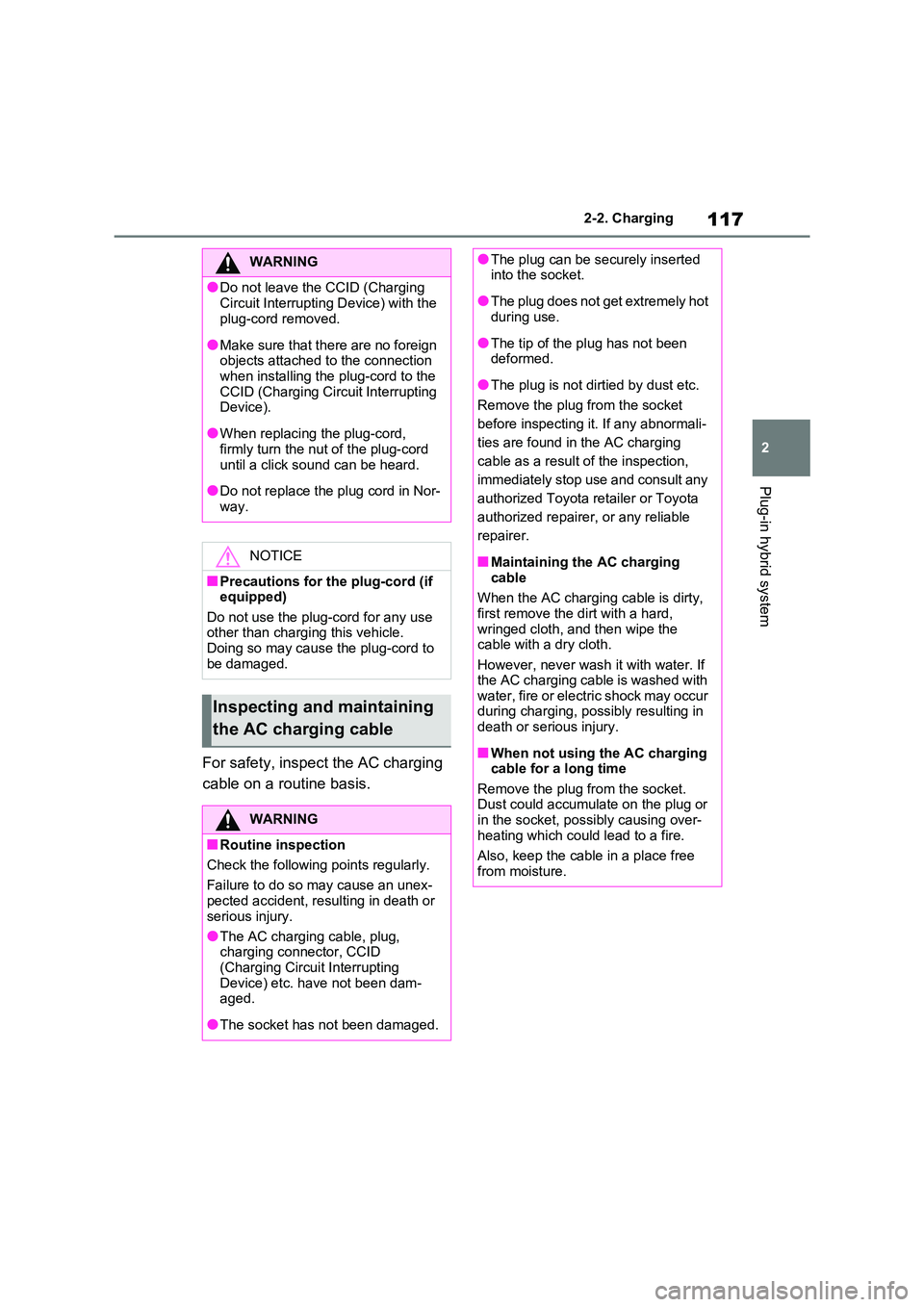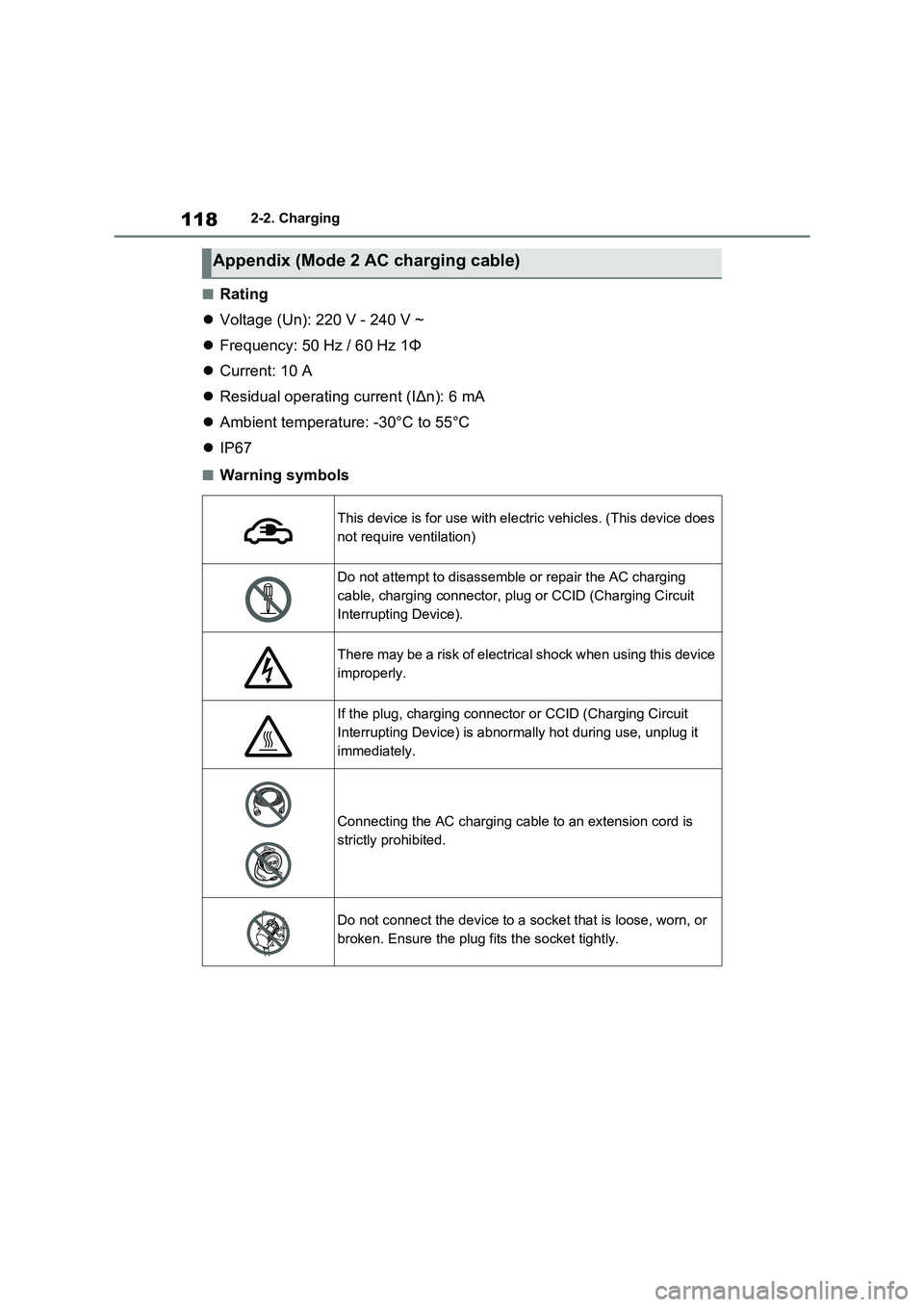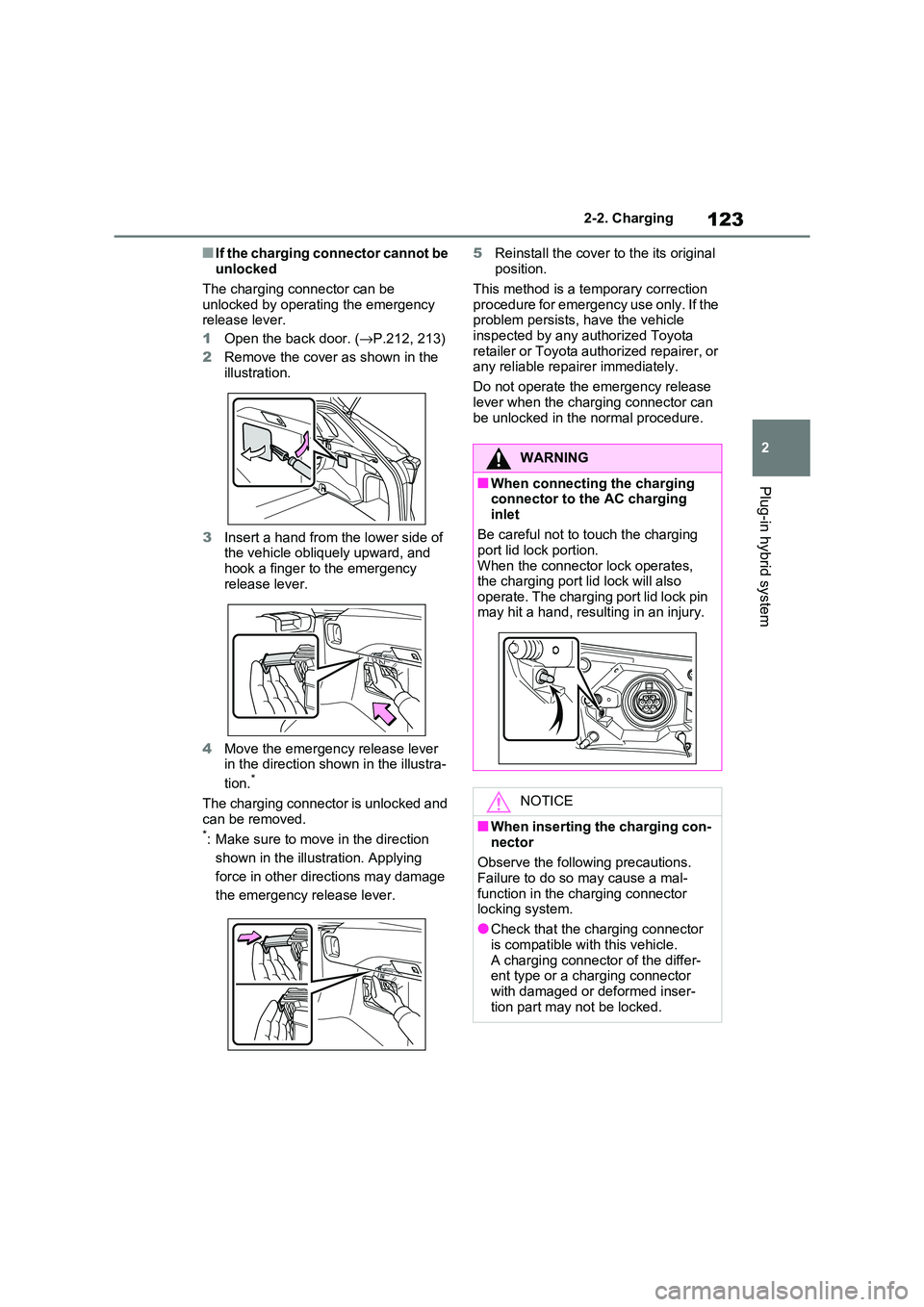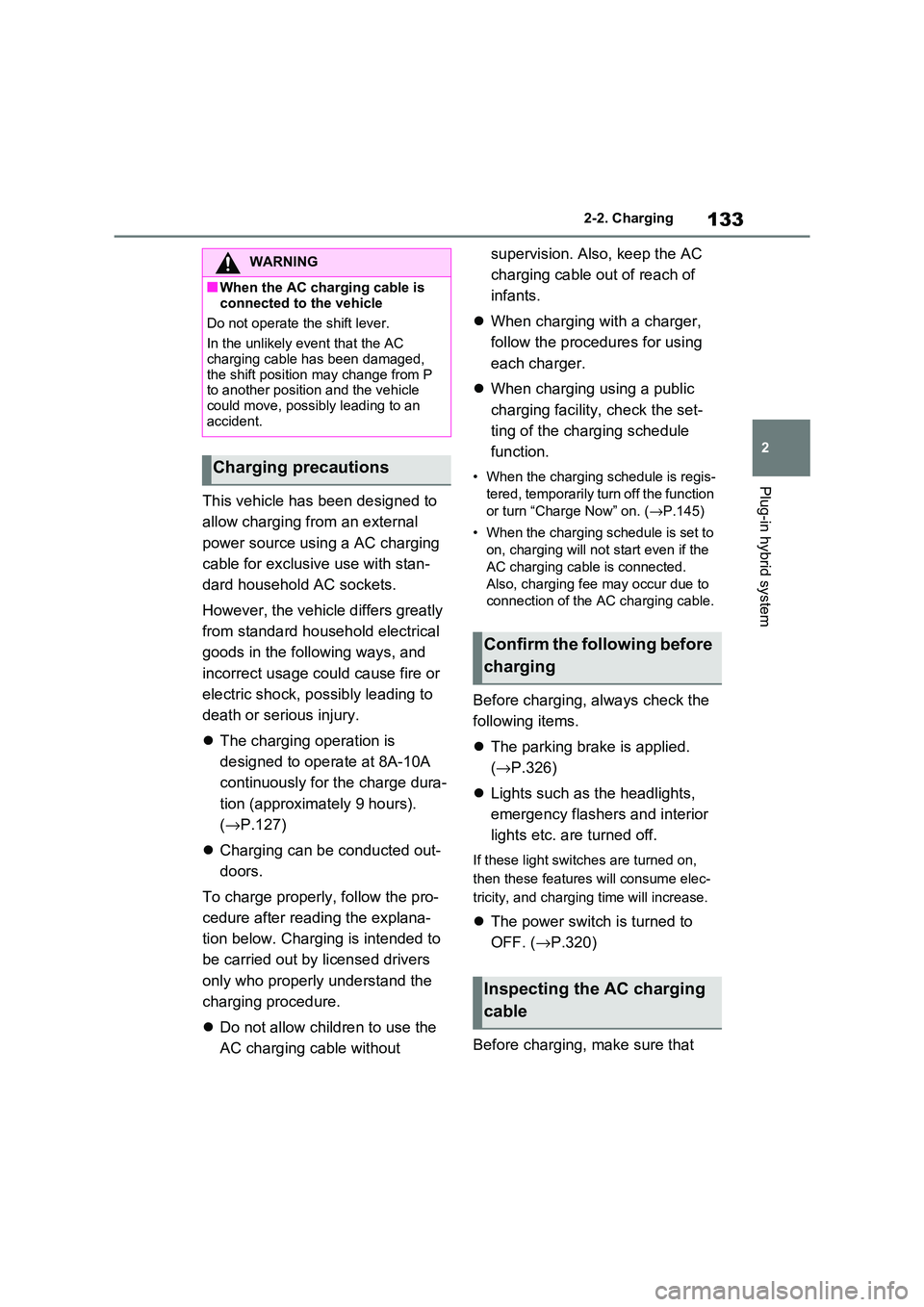2021 TOYOTA RAV4 PHEV warning
[x] Cancel search: warningPage 119 of 666

117
2
2-2. Charging
Plug-in hybrid system
For safety, inspect the AC charging
cable on a routine basis.
WARNING
●Do not leave t he CCID (Charging
Circuit Interrupting Device) with the
plug-cord removed.
●Make sure that there are no foreign
objects attached to the connection when installing the plug-cord to the
CCID (Charging Circuit Interrupting
Device).
●When replacing the plug-cord,
firmly turn the nut of the plug-cord
until a click so und can be heard.
●Do not replace the plug cord in Nor-
way.
NOTICE
■Precautions for the plug-cord (if
equipped)
Do not use the plug- cord for any use other than charging this vehicle.
Doing so may cause the plug-cord to
be damaged.
Inspecting and maintaining
the AC charging cable
WARNING
■Routine inspection
Check the following points regularly.
Failure to do so may cause an unex - pected accident, resulting in death or
serious injury.
●The AC charging cable, plug,
charging connector, CCID (Charging Circuit Interrupting
Device) etc. have not been dam -
aged.
●The socket has not been damaged.
●The plug can be securely inserted into the socket.
●The plug does not get extremely hot during use.
●The tip of the pl ug has not been deformed.
●The plug is not dirtied by dust etc.
Remove the plug from the socket
before inspecting it. If any abnormali -
ties are found in the AC charging
cable as a result of the inspection,
immediately stop use and consult any
authorized Toyota retailer or Toyota
authorized repairer, or any reliable
repairer.
■Maintaining th e AC charging cable
When the AC chargi ng cable is dirty,
first remove the d irt with a hard, wringed cloth, and then wipe the
cable with a dry cloth.
However, never wash it with water. If the AC charging cable is washed with
water, fire or electric shock may occur
during charging, possibly resulting in death or serious injury.
■When not using the AC charging cable for a long time
Remove the plug from the socket.
Dust could accumulate on the plug or in the socket, po ssibly causing over-
heating which coul d lead to a fire.
Also, keep the cable in a place free from moisture.
Page 120 of 666

1182-2. Charging
■Rating
Voltage (Un): 220 V - 240 V ~
Frequency: 50 Hz / 60 Hz 1Φ
Current: 10 A
Residual operating current (IΔn): 6 mA
Ambient temperature: -30°C to 55°C
IP67
■Warning symbols
Appendix (Mode 2 AC charging cable)
This device is for use with electric vehicles. (This device does
not require ventilation)
Do not attempt to disassemble or repair the AC charging
cable, charging connector, pl ug or CCID (Charging Circuit
Interrupting Device).
There may be a risk of electrica l shock when using this device
improperly.
If the plug, charging connector or CCID (Charging Circuit
Interrupting Device) is abnormally hot during use, unplug it
immediately.
Connecting the AC charging c able to an extension cord is
strictly prohibited.
Do not connect the device to a s ocket that is loose, worn, or
broken. Ensure the plug f its the socket tightly.
Page 125 of 666

123
2
2-2. Charging
Plug-in hybrid system
■If the charging connector cannot be
unlocked
The charging connector can be
unlocked by operating the emergency
release lever.
1 Open the back door. (→P.212, 213)
2 Remove the cover as shown in the illustration.
3 Insert a hand from the lower side of the vehicle obliquely upward, and
hook a finger to the emergency
release lever.
4 Move the emergency release lever
in the direction shown in the illustra -
tion.*
The charging connector is unlocked and
can be removed.*: Make sure to move in the direction
shown in the illustration. Applying
force in other directions may damage
the emergency release lever.
5 Reinstall the cover to the its original
position.
This method is a temporary correction
procedure for emergency use only. If the
problem persists, h ave the vehicle inspected by any a uthorized Toyota
retailer or Toyota authorized repairer, or
any reliable repairer immediately.
Do not operate the e mergency release
lever when the charging connector can
be unlocked in the normal procedure.
WARNING
■When connecting the charging connector to the AC charging
inlet
Be careful not to touch the charging port lid lock portion.
When the connector lock operates,
the charging port lid lock will also operate. The charging port lid lock pin
may hit a hand, resulting in an injury.
NOTICE
■When inserting the charging con - nector
Observe the following precautions.
Failure to do so may cause a mal - function in the charging connector
locking system.
●Check that the charging connector is compatible with this vehicle.
A charging connector of the differ -
ent type or a charging connector with damaged or deformed inser -
tion part may not be locked.
Page 126 of 666

1242-2. Charging
Connect to an AC 220 V - 240 V
socket with a Residual Current
Circuit-Breaker (RCCB) and a
circuit breaker. Use of a 13A
individual circuit is strongly rec -
ommended to ensure AC
charging cable will operate prop-
erly.
We strongly recommend that you
use an exclusive connection
from the junction box for
charging. If you connect on a
socket that is on a shared circuit,
and other electrical appliances
are used on other sockets on the
same circuit, then the circuit
breaker might trip.*
Ensure that the junction box is
NOTICE
●Do not apply excessive force to the
charging connector after the
charging connector is inserted. When removing the charging con -
nector, make sure to unlock the
charging connector.
Power sources that can
be used
An external power source that
fulfills the follow ing criteria is
necessary for charging this
vehicle. Confirm this before
charging.
WARNING
■Warnings for electrical faults
Make sure to observe the precautions
in this Owner’s Manual when
charging the vehicle.
Failure to use a power source that ful -
fills the requirements, or failure to
observe regulations while charging could lead to an accident, possibly
resulting in death or serious injury.
Power sources
Page 127 of 666

125
2
2-2. Charging
Plug-in hybrid system
equipped with a Residual Cur -
rent Circuit-Breaker (RCCB). If it
is not, have one installed by a
duly qualified professional.
When charging outdoors, make
sure to connect to a rain-tight
socket that is certified for outdoor
use. Checking Residual Current
Circuit-Breaker (RCCB) opera -
tion before its use is recom -
mended.
Check whether there are any
local EV-charging regulations in
place, and adhere to them.
*: For detailed informa tion, consult an
electrician.
■The charging environment
For safe charging, the following charging equipment and settings are
recommended.
●Rain-tight socket
When charging outdoors, connect the
plug to a rain-tight socket, and ensure
that the plug remains waterproof while
the plug is connected.
●Dedicated circuit
• To reduce the risk of fire, connect only to an at least 13A branch circuit with
an over-current protection.
• To reduce the risk of electric shock when working with the plug, connect
to a socket that has a Residual Cur-
rent Circuit-Breaker (RCCB) installed.
●Remote switch
Allows the electricity from the socket to
be interrupted by operating a switch,
thus allowing safe removal and insertion
of the plug on rainy days.
■When your circuit breaker trips
during charging
The upper limit of the charging current
can be changed in “Vehicle Settings” on
the multi-information display.
1 Press or of the meter control
switches to select .
2 Press or of the meter control
switches to select “ Vehicle Settings”,
and then press and hold .
3 Press or of the meter control
switches to select “Charging Set -
tings”, and then press .
The “Charging Settings” screen will
be displayed.
4 Press or of the meter control
switches to select “Charging Cur -
rent”, and then press .
The “Charging Current” screen will
be displayed.
5 Press or of the meter control
switches to select “16A”*1 or “8A”,
and then press .
The maximum charging current
during charging will be restricted to
16A*1 or 8A.*2
If the breaker still tri ps while charging,
even after changing the upper limit of
the charging current , check if the con- nected power sourc e meets the speci-
fied charging conditions. ( →P.124)*1: Vehicles with 6.6 kW onboard trac-
tion battery charger only
*2: Restricting the charging current will
lengthen the charging time.
WARNING
■Power sources precautions
Observe the following precautions.
If you do not follow them, fire, electri-
cal shock and/or damages may occur,
possibly resulting in death or serious injury.
Page 128 of 666

1262-2. Charging
WARNING
●Connect to an AC 220 V - 240 V
socket with a Residual Current Cir -
cuit-Breaker (RCCB) and supplied by a circuit breaker in line with local
regulations. Use of an individual cir -
cuit provided with at least 13A is strongly recommended.
●Do not connect the AC charging
cable to a multi -socket adaptor, multi-plugs, or conversion plug.
●Connecting the AC charging cable to an extension co rd is strictly pro-
hibited. The extension cord may
overheat and does not contain a Residual Current Circuit-Breaker
(RCCB).
The leakage detection function of the CCID (Charging Circuit Inter -
rupting Device) ( →P.112) may not
operate correctly.
●Do not connect to a power strip.
●Use of a block heater socket which
fails to meet the requirements is prohibited for charging.
●Make sure to connect the charging connector and AC charging inlet
directly. Do not connect a convert -
ing adaptor or extension cord between the charging connector
and AC charging inlet.
Page 134 of 666

1322-2. Charging
where charging cannot be per-
formed occurs.
When a message is displayed, follow
the instructions displayed on the
screen. ( →P.160)
■Multi-information display during
charging
If approximately 100 seconds elapse
after the power switch is turned to ON
during charging, the power switch will automatically turn off and the display will
disappear.
■Safety functions
●The hybrid system wi ll not start while the AC charging cable is attached to
the vehicle, even if the power switch is
operated.
●If the AC charging cable is connected
while the “READY” indicator is illumi- nated, the hybrid system will stop
automatically and dr iving will not be
possible.
Things to know before
charging
Make sure to read the follow -
ing precautions before con -
necting the AC c harging cable
to the vehicle and charging the
hybrid battery (traction bat -
tery).
WARNING
■Caution when charging
People with implantable cardiac pace -
makers or cardiac resynchronization
therapy-pacemakers should not carry out the charging procedure. Ask
someone else to do it.
●Do not approach the charger and
AC charging cable while charging.
Charging procedure may affect the operation of such devices.
●Do not remain in the vehicle during charging.
Charging procedure may affect the
operation of such devices.
●Do not enter the vehicle even to
take something out of the luggage compartment.
Charging procedure may affect the
operation of such devices.
Page 135 of 666

133
2
2-2. Charging
Plug-in hybrid system
This vehicle has been designed to
allow charging from an external
power source using a AC charging
cable for exclusive use with stan -
dard household AC sockets.
However, the vehicle differs greatly
from standard household electrical
goods in the following ways, and
incorrect usage could cause fire or
electric shock, possibly leading to
death or serious injury.
The charging operation is
designed to ope rate at 8A-10A
continuously for the charge dura -
tion (approximately 9 hours).
( →P.127)
Charging can be conducted out-
doors.
To charge properly, follow the pro -
cedure after reading the explana -
tion below. Charging is intended to
be carried out by licensed drivers
only who properly understand the
charging procedure.
Do not allow children to use the
AC charging cable without
supervision. Also, keep the AC
charging cable out of reach of
infants.
When charging with a charger,
follow the procedures for using
each charger.
When charging using a public
charging facility, check the set -
ting of the charging schedule
function.
• When the charging schedule is regis -
tered, temporarily turn off the function
or turn “Charge Now” on. ( →P.145)
• When the charging schedule is set to
on, charging will not start even if the
AC charging cable is connected.
Also, charging fee may occur due to
connection of the A C charging cable.
Before charging, always check the
following items.
The parking brake is applied.
( →P.326)
Lights such as the headlights,
emergency flashers and interior
lights etc. are turned off.
If these light switche s are turned on,
then these features will consume elec-
tricity, and charging time will increase.
The power switch is turned to
OFF. ( →P.320)
Before charging, make sure that
WARNING
■When the AC charging cable is
connected to the vehicle
Do not operate the shift lever.
In the unlikely event that the AC
charging cable ha s been damaged,
the shift position may change from P to another positio n and the vehicle
could move, possibly leading to an
accident.
Charging precautions
Confirm the following before
charging
Inspecting the AC charging
cable